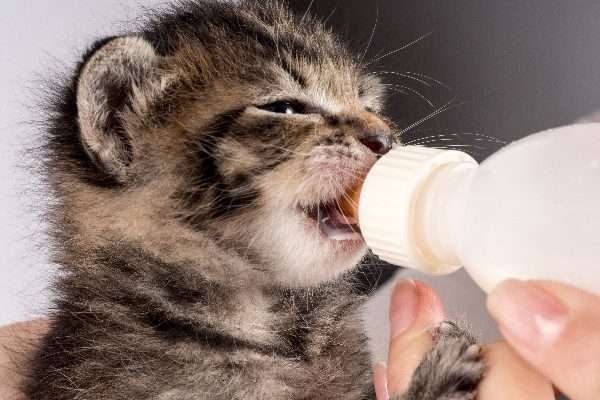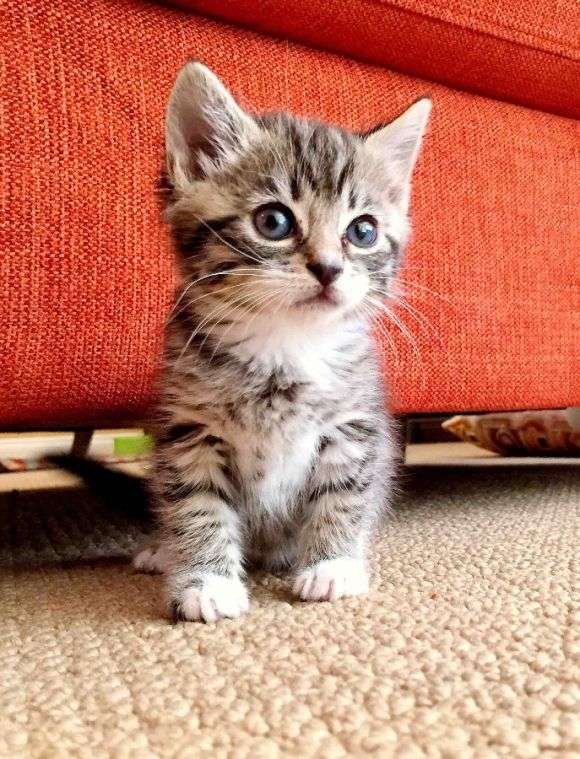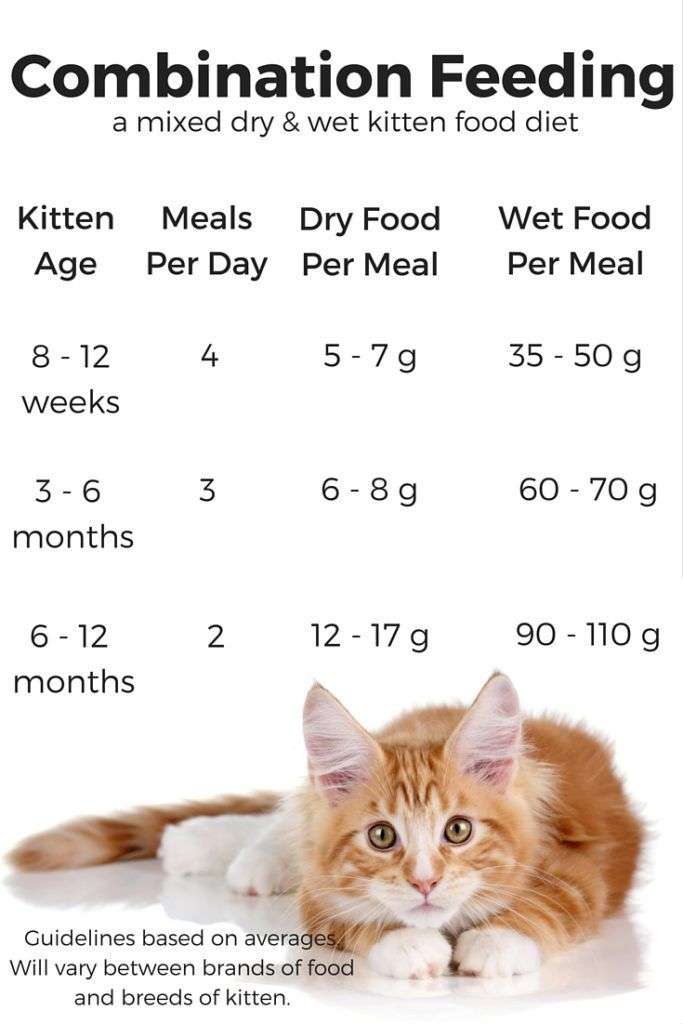How To Wean Kittens
To begin weaning a kitten, mix the kitten food with formula so they recognize the taste. Smear the mixture around their mouth with your finger and let them lick it off. Once they get used to the taste, theyll seek it out elsewhere. Then you can introduce them to lapping from a bowl. Monitor them so they dont lap too fast, and never push their face into the bowl, which could cause them to inhale the mixture and develop pneumonia.
Between the fourth and sixth week, gradually transition the weaning kittens to dry food, supplementing with formula if needed. Use canned food or dry kitten food mixed with water at first, add a lot of water, and then reduce the amount of water as the kitten matures.
A general schedule for kitten weaning might be:
- Weeks 4-5: Give wet or moistened dry food, mixed with formula to form a slush. Supplement with formula if the kitten is not taking to the new food, to make sure it gets enough calories.
- Weeks 5-6: The weaning kittens should start to nibble on the kibble, slightly moistened with water.
- Weeks 6-7: By now, the kitten weaning process is complete, and they should be eating all solid food by week seven.
When To Wean Kittens
Normally, the kitten weaning process begins at about four weeks of age. With mom, theyll start to try to eat her food, and shell push them away from her, says Benson. But if youre weaning a kitten that has been orphaned, you can start a little earlier, between three and four weeks.
When they start biting and chewing on the bottle, theyre ready, says Benson. At this point, you can start to introduce kitten food.
What Are Some Best Practices For Proper Kitten Hygiene
Orphaned kittens require you to pay strict attention to their hygiene for optimal health and development. Follow these best practices for proper kitten hygiene:
- bottles and nipples should be cleaned and then boiled in water to sterilize them between uses.
- never prepare more milk replacer than can be used within 24 hours and always keep it refrigerated.
- discard formula after 1 hour if left at room temperature.
- once or twice each week, gently wash the kittens with a moist cloth.
You May Like: Blue Buffalo Grain Free Cat Food
How Often To Feed Kittens
Younger kittens need to be fed several meals per day, if you are not free-feeding.
As they are growing and burning calories, we want to keep their bodies supplied with energy. Feed meals every 6-8 hours.
Your veterinarian will figure out the total daily calories that your kitten needs, and you can divide that between the number of meals per day. Typically, by the time kittens get to 4-5 months, they can be transitioned to two meals per day, still feeding the total number of daily calories, but in less frequent, larger meals.
Week One Feeding Schedule

A kitten typically weighs about 3 to 3.7 oz. at birth but will gain weight rapidly from nursing. For the first several weeks of life, a newborn kitten will depend entirely on its mother to provide it with food. Its eyes and ears are sealed shut when it’s born, so it will rely on the pheromones its mother gives off to find milk and warmth. Most kittens do just fine without human intervention, but if a kitten needs to be bottle-fed, either because the mother cat is absent, ill, or rejects the kitten, you’ll want to weigh the kitten regularly to make sure its weight reflects a healthy and normal growth rate of a kitten.
A kitten will nurse for about 45 minutes at a time every 2 to 3 hours for the first week of life. The rest of the time will be spent sleeping. Kittens that are bottle-fed should consume about a tablespoon, or 15 ml, of special kitten formula at each feeding. This is very time consuming for someone who is bottle-feeding a newborn kitten, so if at all possible, you will want to try to keep the kitten with its mother or a surrogate lactating cat who can nurse it.
Read Also: Do You Need A Catalytic Converter To Pass Emissions
What Does A 4 Week Old Kitten Eat
Looking after a young kitten can be a challenging task, especially when it comes to ensuring the kitten is properly fed. However, starting at around the four-week mark, kittens are encouraged to stop suckling or bottle feeding and to start eating different kinds of food. This is sometimes referred to as the weaning stage, and although some bottle feeding may still be needed, it is the phase where cats start to eat solids for the first time.
So what does a four-week old kitten eat? Primarily, your kitten should be fed a gruel mixture, made by mixing either wet or dry kitten food with some kitten milk replacement formula and warm water. This should be given several times a day and may need to be supplemented with formula feeding.
In addition to understanding what a four-week old kitten eats, you likely have several other questions: How often should your kitten eat? How many calories does your kitten need? What can you do to encourage your kitten to eat if it is unwilling? And how exactly do you make the ideal gruel mixture, to ensure your kitten transitions to solid foods? I will strive to answer each of these questions, and also offer some extra advice along the way.
Healthy Kitten Growth Rate
A general rule of thumb in kittens is that they typically gain about 1 pound per month.
Often, a kittens weight is about 1 pound at 1 month , 2 pounds at 2 months , and so on until about 4-5 months.
Kittens do most of their growing within the first year and then stabilize from there. Many of the growth plates of the bones in the kitten skeleton close by about one year old.
At this time, after much of the growth is finished, your vet will typically switch your kitten to an adult diet.
You May Like: Can You Bathe Cats With Dawn
My Kitty Missed The 3
Dont worry if your kitten didnt switch to solids at week three. If they are ready to be weaned during their fourth or fifth week, you can skip gruel and introduce them to wet or dry food. You can also mix wet and dry food in a blender to get a thick paste-like texture thatll be easy to lick for first-timers.
Make sure their food is grain-free, minimally processed, and has high protein, moderate fat, and low carb content.
How To Feed Kittens With A Bottle
Bottle feeding kittens may not be the easiest option when they are very young. Many people find that an eye dropper or small syringe works best at first. Once kittens are a bit older, you may still need to try several different nipple styles before you find the one that your kitten uses best.
When youre ready to feed, first make sure the kitten is warm. If their ears, feet or mouth are cool to the touch, they could be hypothermic and unable to digest their food. Under normal circumstances, kittens will snuggle up with their mom and littermates, but hand-raised kittens dont have this natural source of warmth. They must be housed in a warm, draft-free environment with adequate bedding and access to a safe, hot water bottle or heating pad.
Next, place the kitten on a towel on your lap in a normal, belly down position. Never feed a kitten on their back because they may inhale rather than swallow the milk! Support the back of the head with one hand while you guide the nipple into the mouth with the other. Hold the bottle in a tipped position so any air inside is at the point farthest away from the nipple. Watch or gently feel the kittens throat to ensure they are suckling and swallowing. Your veterinarian can give you tips on bottle feeding kittens if you run into trouble.
You May Like: What To Do With A Dead Kitten After Birth
Your Cats Dietary Needs Evolve Over Time
As your cat moves through kittenhood, early adulthood, and beyond, his nutritional needs will change. Meeting those requirements at every phase of life sets the stage for good health.
Your first stop when choosing the right food for your cat? The nutritional adequacy statement.
Usually located on the back of the bag or can, this statement indicates whether or not the food is nutritionally complete and balanced for its intended life stage. The label will read, for example, formulated to meet the nutritional levels established by the AAFCO cat food nutrient profiles for all life stages.
Foods that arent nutritionally complete and balanced will usually be labeled for supplemental feeding only. These foods dont contain the appropriate balance of macronutrients and micronutrients and shouldnt be your cats sole source of nutrition.
While youre looking at the label, check out the feeding instructions as well. For the average house cat, the appropriate feeding instructions are usually already placed on the packaging of the cat food.
The nutritional guidelines on the package will point you in the right direction, though you may need to make some modifications to fit your cats exact needs.
Nutritional Density And 3
When a kitten is 3-weeks old, it is at the point of transitioning to solid food. This means you are to start adding increased amounts of kitten food into the diet of your kitten to aid the milk it gets from its mother or an artificial source.
At this point, you might want to ask how much formula should a 3-week old kitten eat? While the answer to this question is relative, it is crucial for you to know that kittens must be fed different meal from adult cats.
The food formula of a kitten is in line with a much more rigorous nutritional profile than the normal food for adult cats. The reason is that when kittens are adjusted for body weight, they require about two times the amount of calories that adult cats need.
In order to meet the caloric demand of kittens and provide them with the necessary minerals and vitamins to enhance adequate development, the food of kitten is formulated using more nutrient dense food sources.
The food of a kitten is designed to surpass thresholds put in place by the AAFCO . This means foods that are specifically designed for kittens are supposed to meet the adequate development needs of a kitten.
Hence, if you are looking for food for your kitten, you need to opt for one that has been studied and approved by the AAFCO. This is a sign that the food is nutritionally dense to support your kitten through its developmental phase.
Don’t Miss: How Many Calories For Kitten
When To Feed A Kitten
Once you know what to feed your kitten and how much, its time to create a feeding schedule that works for you both.
Use your kittens name when feeding to help her learn her name, while also associating you with a pleasant activity.
Creating a routine and feeding her at the same time each day can help your kitten feel secure and will aid in forming a bond between you two that will last for many years to come.
You can feed your kitten one to three times a day, as long as you dont give her more than her total daily calorie needs.
For example, you can put dry kibble in her bowl in the morning and she can graze throughout the day. If a twice-a-day schedule works better, give half her daily amount in the morning and half in the evening.
Same for wet food or a combination of wet and dry food. Just make sure the wet and dry food combined meets the total amount of calories she needs in a day.
Feeding Kittens 8 Weeks To 6 Months Oldand Beyond

Between 8 weeks and 6 months old, continue feeding your kitten three to four times per day. Only offer food formulated especially for kittens that says complete and balanced on the label. By the time your kitten is 6 months old, you can cut back meals to twice a day until they are a year old.
RELATED: How Much Should I Really Feed My Cat?
Don’t Miss: Why Is My Cat So Aggressive All Of A Sudden
Spay Or Neuter And Adoption
Eight-week-old healthy kittens are fully weaned and should soon be ready to be spayed or neutered and to find their new forever homes. It is much easier to find homes for eight-week old kittens than it is if you wait longer, so start setting a plan early on. Sharing photos of the kittens with friends and family as they grow, and telling everyone you know that youll be looking for homes for the kittens is a great way to find homes. For more advice on finding homes for the kittens, see this guide on finding homes for homeless pets.
It is also important to ensure that all the kittens are spayed or neutered, so they dont accidentally add to the thousands of unplanned litters of kittens that enter shelters each year. Find a low-cost spay/neuter clinic near you.
While caring for orphaned kittens is a lot of work, its also a lot of fun. The most rewarding part is watching your charges grow up and go into new homes. And the best part is that you can feel good knowing that you helped keep kittens the most at-risk animals to enter shelters safe and sound.
Just Before You Feed A Stray Kitten
Its important that you determine the age of a stray cat before feeding it.
Besides making sure that its rapidly growing and developing body will be properly nourished, you should also see to it that the stray kitten wont experience an upset stomach, nausea, vomiting, and diarrhea due to giving it food thats not appropriate for it.
The Pet Rescue is a participant in the Amazon Services LLC Associates Program, an affiliate advertising program designed to provide a means for sites to earn advertising fees by advertising and linking to Amazon.com. We also participate in other affiliate programs which compensate us for referring traffic.
Disclaimer: The views and opinions expressed in this article are those of the authors and do not necessarily represent those of The Pet Rescue.
Recommended Reading: Cat Daily Calorie Intake
Fresh And Salt Water Fish
Your kitten will be happy if you share your cooked fish with her. A tiny bit of trout, catfish, salmon or tuna will each be appreciated although, really, any cooked fish is fine. Again, give her just a tiny bit is plenty even if shes begging for more. You can also try Honest Kitchens Mmmixers, a tasty meal topper made with salmon and pollock.
Feeding Three Week Old Kittens
Do Kittens Need Bottle Feeding? The short answer is, Yes!
Ive said it before and I will say it again, this is probably one of the most important things to understand when caring for an orphaned kitten and what a lot of people tend to have issues on.
You will probably have guessed that a newborn kitten will need to be bottle-fed. And you are correct. Kittens need to be bottle-fed until anywhere from 5-8 weeks until their baby teeth come in.
Don’t Miss: Blue Healthy Gourmet Cat Food Reviews
Adopting Out The Kittens
The final step. Successful socialization is the most important part of the process, so make sure you teach them to trust and like humans as early as you are able! Please spay and neuter them before you adopt them out , they will not only be more attractive to adopters, but it will also help prevent this cycle from happening all over again. Once they are fixed, advertise liberally! Use social networking sites, tells friends, relatives, colleagues and acquaintances, and get them adopted out as early as you can! The older the kittens get, the harder it will be to find them homes.
How Much Does A Three Week Old Kitten Weigh
Their weight at this age should be between 350-450 grams depending on the kitten and should continue to steadily gain weight each day.
If you notice your kitten is not gaining weight for a few days, make sure you are feeding them enough, and speak to your vet about possible other reasons for delayed weight gain.
Recommended Reading: Blue Wilderness Cat Food Kitten
About Dr Pete Wedderburn Dvm
Dr Pete Wedderburn qualified as a vet from Edinburgh in 1985 and has run his own 4-veterinarian companion animal practice in County Wicklow, Ireland, since 1991. Pete is well known as a media veterinarian with regular national tv, radio and newspaper slots, including a weekly column in the Daily Telegraph since 2007. Pete is known as “Pete the Vet” on his busy Facebook, Instagram and Twitter pages, regularly posting information on topical subjects and real-life cases from his clinic. He also write a regular blog at www.petethevet.com. His latest book: Pet Subjects, was published by Aurum Press in 2017.
Newborn Kitten Age: 0

During this stage, most kittens rely on their mothers milk as their only source of nutrition. If their mother is present, you wont need to feed kittens at alltheyll know how to feed themselves! That said, if youve rescued an orphaned kitten, youll need to bottle feed him. Kittens require a kitten milk replacer, which replicates the nutrition found in mother cats milk. Do not feed a kitten cows milkit doesnt have the right nutritional balance to nourish a newborn kitten.
You May Like: Blue Buffalo Adult Cat Food